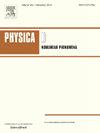Effects of Atwood number and isothermal stratification strength on single-mode compressible Rayleigh–Taylor instability
IF 2.7
3区 数学
Q1 MATHEMATICS, APPLIED
引用次数: 0
Abstract
The coupled effects of the variable-density and compressible isothermal background stratification strength on the growth of the fully compressible single-mode two-dimensional two-fluids Rayleigh–Taylor instability (RTI) are examined using direct numerical simulations (DNS) with varying Atwood numbers, = 0.1, 0.3, and 0.5; and different background isothermal Mach numbers, = 0.3, 0.9, and 1.5, respectively, in the problem Reynolds number, , range of 6375 to 51000. The results show that higher stratification strength leads to more suppression of the RTI growth for the cases with a low Atwood number. However, when the Atwood number is high, the suppression effect of compressible background stratification on the RTI growth becomes nonlinear with , and in general, it becomes weaker. Furthermore, for the case with the highest background stratification strength and highest Atwood number, we observe local supersonic regions and even shock waves with increasing at late time during the mixing. Additionally, a relevant transport equation for mixing is studied, and it is found that diffusion and production terms are dominant, and the redistribution term becomes more important with a larger Atwood number.
Vortex dynamics are also analyzed using normalized vorticity and its transport equation. It is observed that for cases at various Atwood numbers, increasing Mach number generally suppresses the growth of the vortical structures. Examining the vorticity transport equation, it is shown that the baroclinicity and viscous diffusion terms are the major contributors to the change of vorticity in cases with different combinations of and . In addition, with increasing , the vorticity-dilatation term becomes more significant due to the flow compressibility effects. It is also noticeable that small-scale vortical structures become more pronounced with increasing for all Atwood numbers.
求助全文
约1分钟内获得全文
求助全文
来源期刊

Physica D: Nonlinear Phenomena
物理-物理:数学物理
CiteScore
7.30
自引率
7.50%
发文量
213
审稿时长
65 days
期刊介绍:
Physica D (Nonlinear Phenomena) publishes research and review articles reporting on experimental and theoretical works, techniques and ideas that advance the understanding of nonlinear phenomena. Topics encompass wave motion in physical, chemical and biological systems; physical or biological phenomena governed by nonlinear field equations, including hydrodynamics and turbulence; pattern formation and cooperative phenomena; instability, bifurcations, chaos, and space-time disorder; integrable/Hamiltonian systems; asymptotic analysis and, more generally, mathematical methods for nonlinear systems.
 求助内容:
求助内容: 应助结果提醒方式:
应助结果提醒方式:


